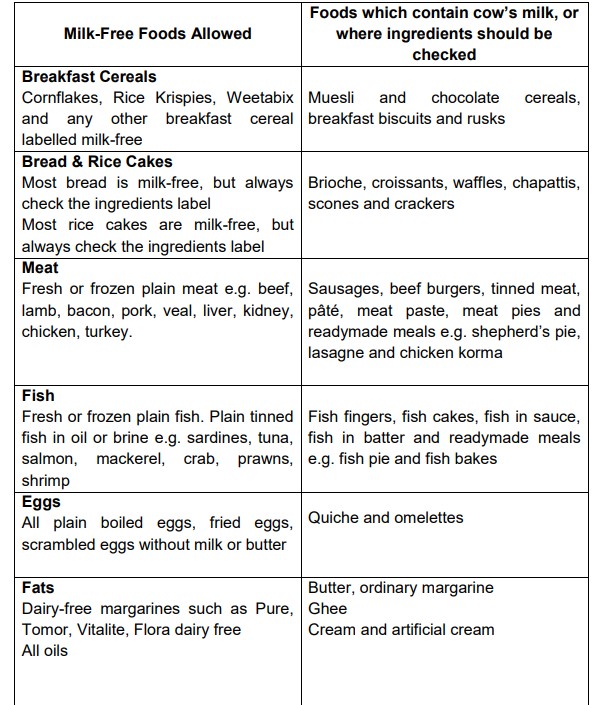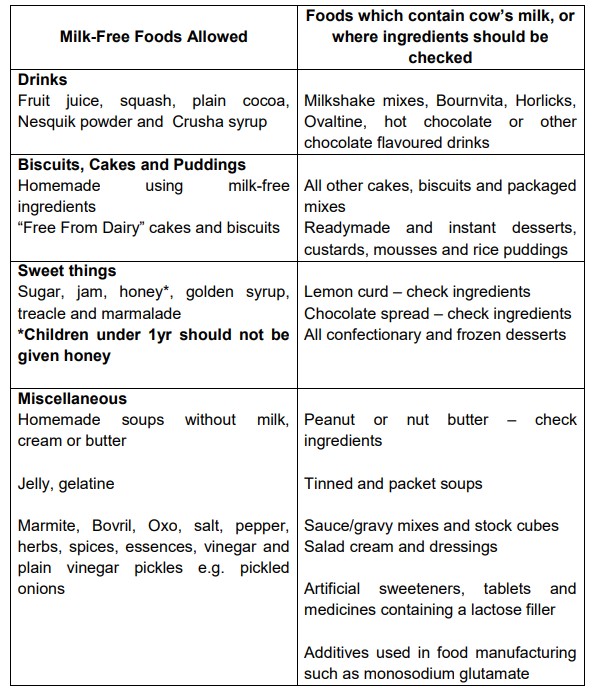Cow’s milk-free diet for infants
Please note, this page is printable by selecting the normal print options on your computer.
Why does my baby need a cow’s milk free diet?
We have advised your baby follows a cow’s milk free diet because he/she may have an allergy to cow’s milk protein. There are two types of cow’s milk protein allergy, IgE mediated and non IgE mediated. Cow’s milk protein allergy is not the same as a lactose intolerance, although the diet used to treat them is very similar.
From 0-6 months old
For the first 6 months of life, babies only need a diet of breastmilk or infant formula. If the infant is breastfed, mum may also need to follow a cow’s milkfree diet if your baby has symptoms with breastfeeds. If you are not breastfeeding your baby or wish to start an infant formula, you will need to use a specialist cow’s milk-free infant formula which can be prescribed by your GP. When you change your baby to the new formula milk, you may find their stools (poo) change and become may be green in colour. From around six months of age they should start solids (weaning). Babies who are allergic to cow’s milk protein will need to follow a cow’s milk-free diet.
After 6 months: Introducing solid food
Weaning a baby who is allergic to cow’s milk is just like weaning any other baby, except that their food must be cow’s milk-free. EU law states that all foods containing milk, even in the smallest quantities, must have this clearly emphasised on the ingredient list. Usually manufactures do this by writing the ingredient in bold, but sometimes it will be in a different colour or in italics. If you buy a food that is sold loose, or you eat out, the information should be available separately, or a member of staff in the shop/restaurant should be able to tell you if it contains cow’s milk.
How do I know that it is time to start weaning?
Every baby is an individual but there are some clear signs which show that they are ready to begin eating solids. It is rare for babies to show all of these signs before they are 6 months old:
Your baby can stay in a sitting position and hold their head steady.
Your baby has good co-ordination so that they are able to look at their food, pick it up and put it into their mouths by themselves. They may already be doing this with toys.
Your baby can swallow food rather than pushing their food out with their tongue
For more advice on weaning, talk to your Health Visitor, or go to www.nhs.uk/start4life or www.nhs.uk/weaning.
What cow’s milk-free foods should I start with?
Some good first foods could be mashed or soft cooked sticks of fruit and vegetables such as apple, pear, banana, avocado, carrot, potato, sweet potato, butternut squash and parsnip, or you could try baby rice mixed with some of your baby’s cow’s milk-free formula or breastmilk
Mashed foods may also be mixed with cow’s milk-free substitutes such as almond, oat, hazelnut* or soya* milk. You could also add a dairy free margarine such as Pure margarine, Vitalite or Flora dairy free.
Don’t add any salt, sugar or stock cubes to your baby’s food or cooking water
We recommend that other foods which may cause allergic reactions, such as eggs, wheat, gluten, soya, fish, shellfish, peanuts, tree nuts and seeds should be included in your baby’s diet from when you start solids. Waiting until later may make your baby more likely to have an allergic reaction. They should be introduced one at a time, with a gap of 3 days in between each new food, so that it is easier to work out food that causes a reaction.
Top tips for starting weaning
Start by offering just a few pieces or spoons of food, once a day, at a time when your baby is awake and alert. Gradually increase the amounts you feed, offering a second and third meal, over about a month
Let your baby enjoy touching and holding their food
If you are using a spoon, wait for your baby to open their mouth before you offer the food
Don’t force your baby to eat if they do not seem interested
Introduce new foods one at a time, so your baby can get used to new tastes. If they don’t seem to like a food, introduce it again on a different day. Try each food several times before you decide he/she doesn’t like it.
Always stay with your baby when they are eating in case they choke.
From 8-9 months of age
Gradually, your baby will move on to eating 3 meals a day with a mix of finger foods, mashed and chopped foods.
The following chart will help you provide a cow’s milk-free diet for your child:



Don’t forget!
Since food manufacturers may change the ingredients in their pre-packaged and ready-made foods always check the label of all the foods you buy every time you buy them.
Calcium and sugary foods
Some of the dairy-free ‘milks’ and products are great sources of calcium but they may also contain high amounts of sugar. Always look after your child’s teeth by brushing them at least twice a day. Keep sugary foods and drinks to mealtimes to keep their teeth and gums healthy. Some of the organic milkfree foods available are not fortified with extra calcium. Read the label to ensure that you are choosing the version of foods and drinks that are fortified with calcium where possible.
How will I know if my child has grown out of their milk allergy?
Cows’ milk allergy is common in babies and children. Many children with this condition grow out of it by school age. If you child has a cow’s milk protein allergy, always talk to your paediatrician,
doctor, health visitor or the dietitian before re-trying milk at home.
